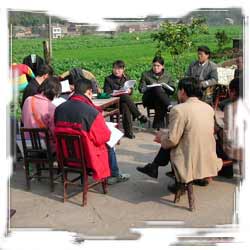Genes explain the amazing global spread of maize
CIMMYT E-News, vol 4 no. 5, May 2007
No need to dig for ancient seeds to discover how and when maize moved from its ancestral home in Mesoamerica to become one of the world’s most widely-sown and popular food crops. New work by gene sleuths from CIMMYT and numerous maize growing countries solves the puzzle using DNA of present-day maize.
How did a crop domesticated some 7,000 years ago from a humble Mexican grass called teosinte become the number-one food crop in Africa and Latin America, and a major food, feed, and industrial crop just about everywhere else?
The incredible story of maize has been told in books, but there have always been lingering doubts, unanswered questions. If, for example, as records show, in 1493 Columbus brought maize to Spain from his visit to the warm climes and long days of the Caribbean, how is it that reliable accounts have the crop being grown in 1539 in the cold, short daylengths of Germany? That’s only 46 years later, and far too soon for such a radical adaptation in tropical maize. In another case, maize was supposedly brought to African countries like Nigeria by Portuguese colonists, but the local names for maize in that country are of Arabic derivation, suggesting that the crop likely arrived via Arabic-speaking traders.

Deciphering the history in genes
Recent work by CIMMYT and partners sheds new light on maize’s global migration. With support from Generation, a Challenge Program of the Consultative Group on International Agricultural Research, and in collaboration with nine research institutes on four continents, scientists have used DNA markers—molecular signposts for genes of interest—and new approaches to analyze nearly 900 populations of maize and teosinte from around the world. “What is emerging is a far clearer picture of the crop’s global diversity and the pathways that led to it,” says CIMMYT molecular geneticist and leader of the effort, Marilyn Warburton.
Phase I of the work was funded by PROMAIS, a European maize consortium, and focused on North America and Europe. The Generation Challenge Program commissioned Phase II, which featured global coverage and brought the number of maize populations studied to 580. In Phase III, partners are adding another 300 populations of maize and teosinte, to fill any geographical gaps. A primary objective is to gather samples of landraces—local varieties developed through centuries of farmer selection—and ensure their conservation in germplasm banks. The diversity studies apply a method developed by Warburton for using DNA markers on bulk samples of individuals from large, heterogeneous populations like those typical for maize.
The great divide: Temperate vs tropical maize
Among other things, the studies corroborate the notion that northern European maize originates from North American varieties brought to the continent several decades after Columbus’ returned, and definitely not from tropical genotypes. “The two main modern divisions of maize arose about 3,000 years ago,” says Warburton, “as maize arrived in what is now the southwestern US and, at about the same time, on the islands of the Caribbean. Temperate maize spread further north and east across North America, while tropical maize spread south. The temperate-tropical division remains today. What maintains it are differences in disease susceptibility and photosensitivity—essentially, how daylength affects flowering time. The two maize types are now so different from each other that they do not cross well, and their hybrids are not well adapted anywhere.”
The work continues and, in addition to elucidating the epic journey of maize, will help breeders to home in on and more effectively use traits like drought tolerance from the vast gene pool of maize.
The above report is largely based on a longer description of this work, “Tracing history’s maize,” that appears in Generation’s “Partner and Product Highlights 2006.”
For more information: Marilyn Warburton, molecular geneticist (m.warburton@cgiar.org)
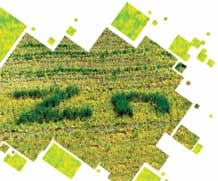 Thanks to pioneering research in Turkey, the links between zinc-deficient soils, plants, people, and continued malnutrition and poverty have been clearly articulated. Few other countries in the world are as well placed to show how plant breeding research can limit the impact of zinc deficiency on crop and human health. So what’s the next step?
Thanks to pioneering research in Turkey, the links between zinc-deficient soils, plants, people, and continued malnutrition and poverty have been clearly articulated. Few other countries in the world are as well placed to show how plant breeding research can limit the impact of zinc deficiency on crop and human health. So what’s the next step? HarvestPlus for a More Nutritious Harvest
HarvestPlus for a More Nutritious Harvest
 As part of its contribution to HarvestPlus, the CGIAR’s global alliance to breed and disseminate crops for better nutrition, CIMMYT is developing nutritionally enhanced wheat varieties that will automatically increase people’s intake of essential dietary elements like zinc. Given that CIMMYTderived spring bread wheat varieties are planted on 80% of the global spring wheat area, the impacts could be wide-ranging.
As part of its contribution to HarvestPlus, the CGIAR’s global alliance to breed and disseminate crops for better nutrition, CIMMYT is developing nutritionally enhanced wheat varieties that will automatically increase people’s intake of essential dietary elements like zinc. Given that CIMMYTderived spring bread wheat varieties are planted on 80% of the global spring wheat area, the impacts could be wide-ranging.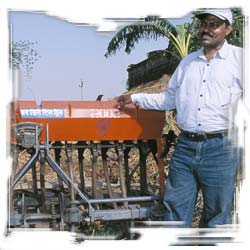 This is the story of Anil Singh, a farmer from the remote, relatively poor area of Uttar Pradesh, India, who found fortune with help from CIMMYT-South Asia Regional Program and the Rice Wheat Consortium for the Indo-Gangetic Plains (RWC). His eye-catching success has been based on reduced tillage and direct seeding of wheat.
This is the story of Anil Singh, a farmer from the remote, relatively poor area of Uttar Pradesh, India, who found fortune with help from CIMMYT-South Asia Regional Program and the Rice Wheat Consortium for the Indo-Gangetic Plains (RWC). His eye-catching success has been based on reduced tillage and direct seeding of wheat.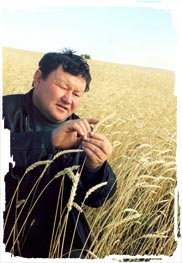 A Kazakh farmer wins by adopting CIMMYT-led technology.
A Kazakh farmer wins by adopting CIMMYT-led technology.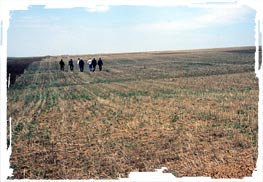
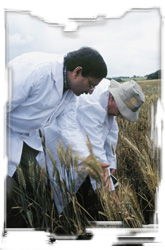 CIMMYT’s Ravi Singh is named outstanding CGIAR scientist for 2005.
CIMMYT’s Ravi Singh is named outstanding CGIAR scientist for 2005.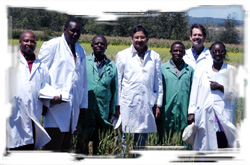
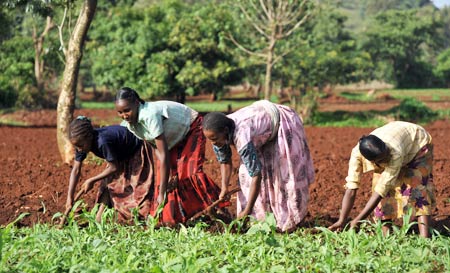 Bold Initiative Tackles Hunger in Developing World
Bold Initiative Tackles Hunger in Developing World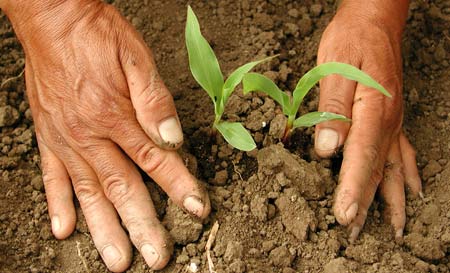 The
The 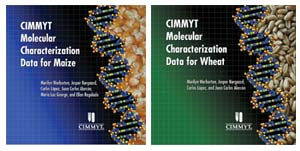 In November CIMMYT unveiled a significant addition to the field of DNA fingerprinting for wheat and maize. Two databases, fashioned by molecular geneticist Marilyn Warburton and her team, are the largest public information sites of their kind.
In November CIMMYT unveiled a significant addition to the field of DNA fingerprinting for wheat and maize. Two databases, fashioned by molecular geneticist Marilyn Warburton and her team, are the largest public information sites of their kind.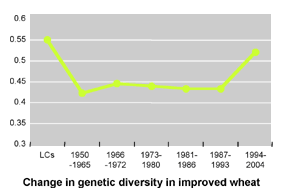 Maize database: http://staging.cimmyt.org/english/docs/manual/dbases/contents_mz.htm
Maize database: http://staging.cimmyt.org/english/docs/manual/dbases/contents_mz.htm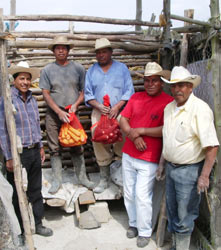 The State of Mexico borders the country’s capital, Mexico City—a potential market of nearly 20 million inhabitants—but farmers there have struggled to make a profit growing maize. CIMMYT is working to help them, as part of a new partnership between the US Department of Agriculture (USDA) and the Mexican Agriculture Secretariat (SAGARPA).
The State of Mexico borders the country’s capital, Mexico City—a potential market of nearly 20 million inhabitants—but farmers there have struggled to make a profit growing maize. CIMMYT is working to help them, as part of a new partnership between the US Department of Agriculture (USDA) and the Mexican Agriculture Secretariat (SAGARPA). Years of low prices, until recently, for maize grain have discouraged farmers from investing in advanced practices or new varieties. “The state of Mexico accounts for ten percent of national maize production, but improved varieties occupy little more than a tenth of its maize area,” says CIMMYT maize researcher Silverio García. “And nearly all the maize they produce is white grained and ideal for local foods, but fails to meet market standards for large-scale, commercial tortilla production, feed or industrial uses.”
Years of low prices, until recently, for maize grain have discouraged farmers from investing in advanced practices or new varieties. “The state of Mexico accounts for ten percent of national maize production, but improved varieties occupy little more than a tenth of its maize area,” says CIMMYT maize researcher Silverio García. “And nearly all the maize they produce is white grained and ideal for local foods, but fails to meet market standards for large-scale, commercial tortilla production, feed or industrial uses.”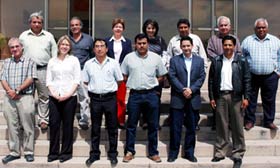 Atlin and Garcia recently led a workshop of 11 maize scientists from the Mexican National Institute of Forestry, Agriculture, and Livestock Research (INIFAP), Mexico State’s Institute of Agriculture, Livestock, Water, and Forestry Research and Training (ICAMEX), the Colegio de Postgraduados (a graduate-level agricultural research and learning institution), and CIMMYT to plan project activities. Participants contributed detailed information on varieties grown in the state, agreed on common software for managing and analyzing data from trials, and discussed ways to foster farmer participation.
Atlin and Garcia recently led a workshop of 11 maize scientists from the Mexican National Institute of Forestry, Agriculture, and Livestock Research (INIFAP), Mexico State’s Institute of Agriculture, Livestock, Water, and Forestry Research and Training (ICAMEX), the Colegio de Postgraduados (a graduate-level agricultural research and learning institution), and CIMMYT to plan project activities. Participants contributed detailed information on varieties grown in the state, agreed on common software for managing and analyzing data from trials, and discussed ways to foster farmer participation.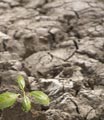 They often have few options other than to obtain their food and income from agriculture. Achieving food security is the incentive for many to allocate a disproportionately large part of their land to maize, leaving little area to other crops such as legumes or cash crops. Human malnutrition and soil degradation are frequent and few escape the “poverty trap.”
They often have few options other than to obtain their food and income from agriculture. Achieving food security is the incentive for many to allocate a disproportionately large part of their land to maize, leaving little area to other crops such as legumes or cash crops. Human malnutrition and soil degradation are frequent and few escape the “poverty trap.”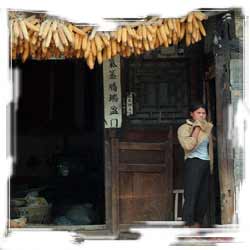 The demand for maize in Asia is expected to skyrocket in the next two decades, driven primarily by its use for animal feed. In the uplands of seven Asian countries, however, demand is also increasing in the farming households who eat the maize crops they grow. CIMMYT and the
The demand for maize in Asia is expected to skyrocket in the next two decades, driven primarily by its use for animal feed. In the uplands of seven Asian countries, however, demand is also increasing in the farming households who eat the maize crops they grow. CIMMYT and the 